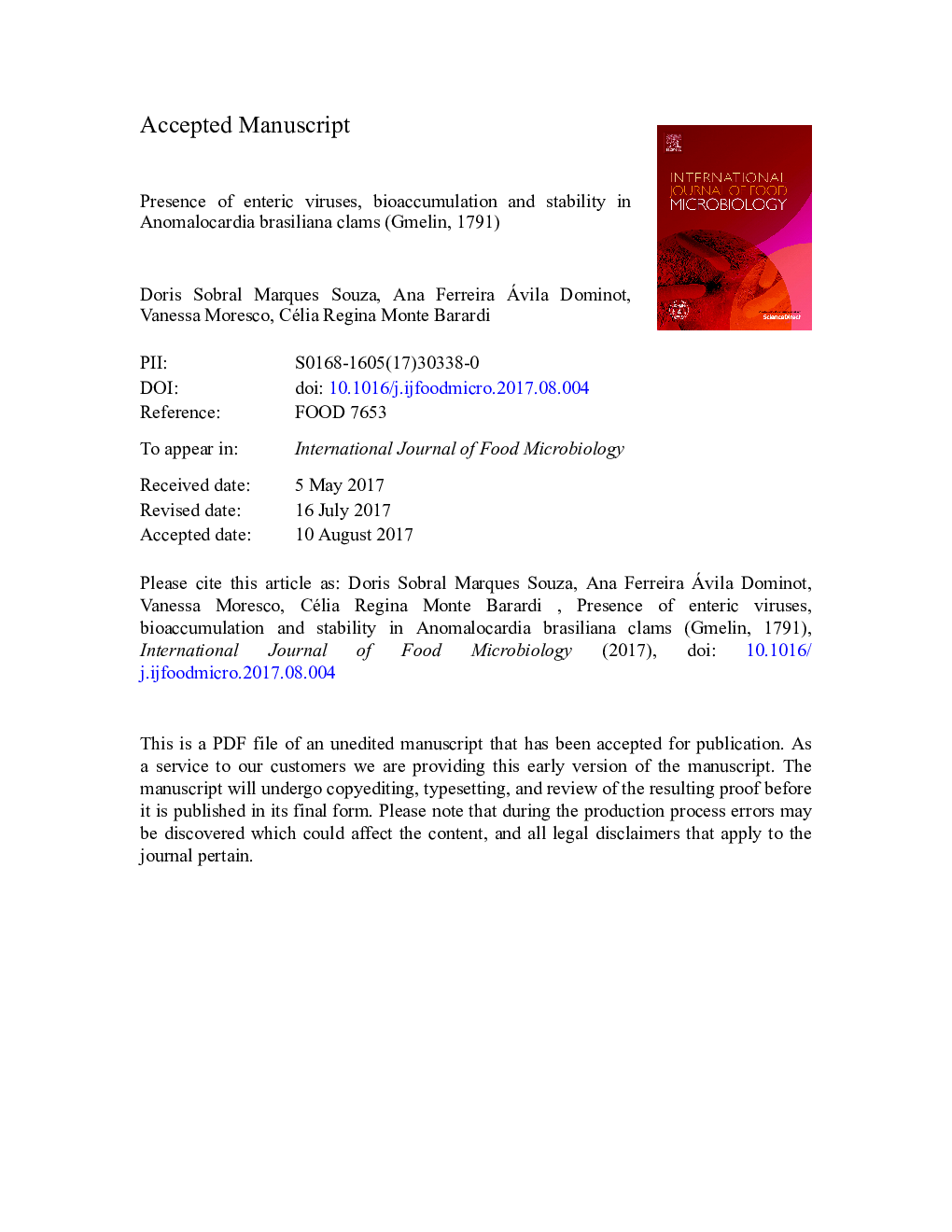| کد مقاله | کد نشریه | سال انتشار | مقاله انگلیسی | نسخه تمام متن |
|---|---|---|---|---|
| 8844346 | 1616517 | 2018 | 35 صفحه PDF | دانلود رایگان |
عنوان انگلیسی مقاله ISI
Presence of enteric viruses, bioaccumulation and stability in Anomalocardia brasiliana clams (Gmelin, 1791)
دانلود مقاله + سفارش ترجمه
دانلود مقاله ISI انگلیسی
رایگان برای ایرانیان
موضوعات مرتبط
علوم زیستی و بیوفناوری
علوم کشاورزی و بیولوژیک
دانش تغذیه
پیش نمایش صفحه اول مقاله

چکیده انگلیسی
Bivalve mollusks are filter feeders and may accumulate human pathogens in their tissues. Many studies demonstrated human diseases associated with bivalve consumption, especially oysters. Anomalocardia brasiliana clams are distributed along the Brazilian coastal area and are an exotic ingredient for some typical dishes in Brazil. Even though there are several reports describing the contamination of oysters and mussels with human pathogens, there is a lack of studies reporting contamination of A. brasiliana with human pathogens. An evaluation of natural microbiological contamination in A. brasiliana samples over a period of 18 months (November 2014 to April 2016) showed that the bacteria indices were in accordance with Brazilian regulations (E. coli < 230 MPN and Salmonella sp. absent in 25 g of meat). However, the enteric viruses evaluated were detected throughout the analysis period, with the highest result for the hepatitis A virus (HAV); followed by Rotavirus-A (RVA); Human Adenovirus (HAdV) and Norovirus GI (NoV GI). The bioaccumulation of enteric viruses by A. brasiliana during a period of 24 h was performed using NoV GI and GII, HAV, RVA and HAdV as models. Interestingly the mollusk demonstrated different uptake behaviors in relation to these viruses throughout the time period. NoV GI was the most adsorbed virus after 24 h. HAV concentration was < 1% at 3 h, but it increased to < 10% at 8 h, remaining unchanged until 12 h, and decreasing to < 3% at 24 h; HAdV reached its highest concentration at 12 h, being released by the animals and lowering to < 3% at 24 h. RVA bioaccumulation was unstable over time, reaching its highest values after 24 h (< 5%); NoV GII bioaccumulation remained < 1%. Thermal inactivation of HAdV-2 in A. brasiliana was also evaluated. After the usual gentle cooking procedure using different times (0, 1, 1.5, 3 and 5 mins), viral infectivity was evaluated using ICC-et-RT-qPCR. The temperature inside the DT remained < 80 °C over time and after 5 min of cooking the HAdV reached a decay of 90% (1 log10). The results showed a real warn to the consumers that can be exposed to infectious human viruses if they eat these clams improperly cooked. HAV was the most detected virus in these animals, which may lead to outbreaks. A. brasiliana exhibited distinct behavior in NoV GI bioaccumulation and persistence, pointing to the need for further studies about the cellular ligands used by these viruses to become attached to these clams.
ناشر
Database: Elsevier - ScienceDirect (ساینس دایرکت)
Journal: International Journal of Food Microbiology - Volume 266, 2 February 2018, Pages 363-371
Journal: International Journal of Food Microbiology - Volume 266, 2 February 2018, Pages 363-371
نویسندگان
Doris Sobral Marques Souza, Ana Ferreira Ávila Dominot, Vanessa Moresco, Célia Regina Monte Barardi,